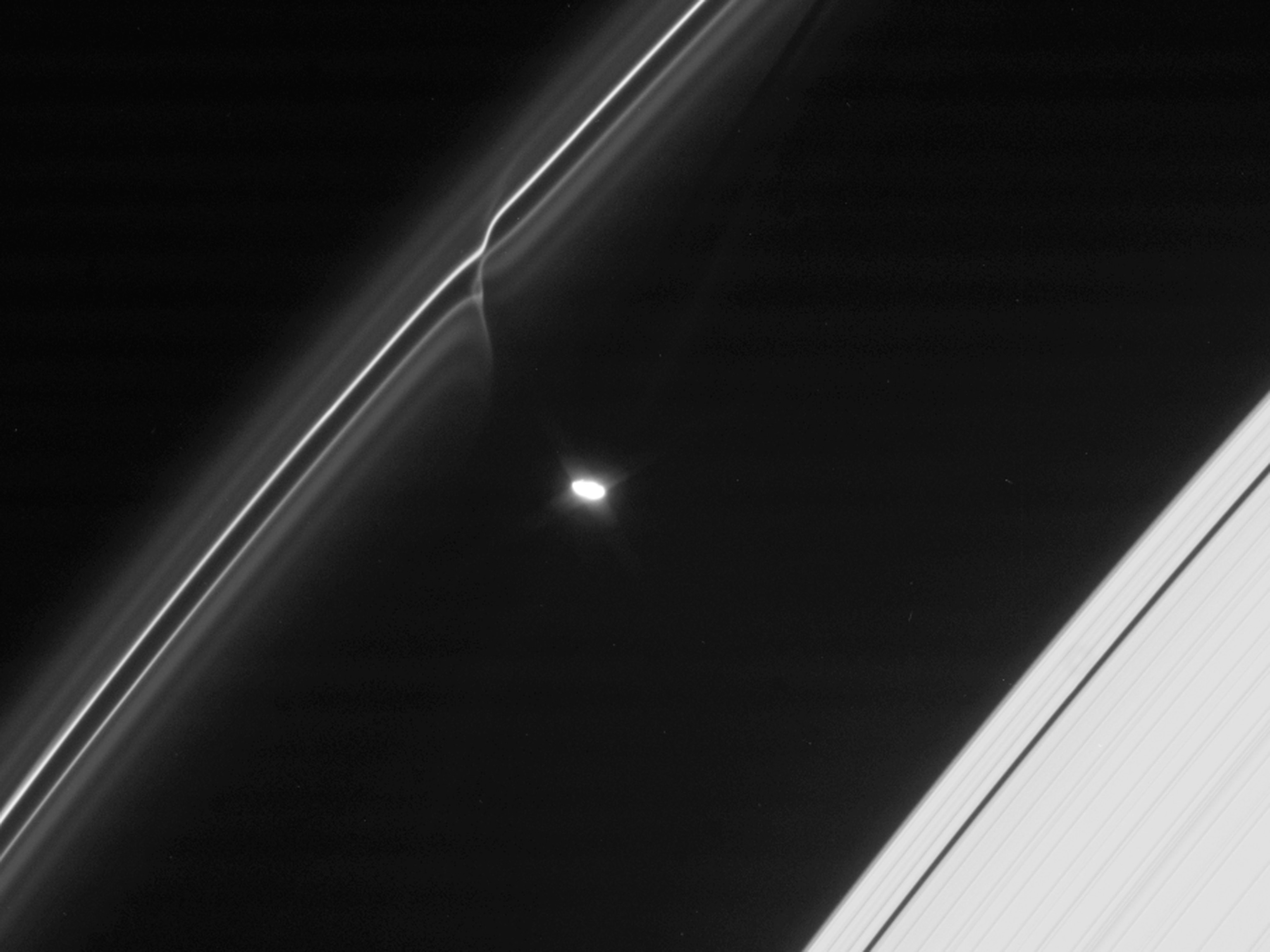
Saturn's Rings Hit by Meteor Shower
Cassini spacecraft spies dust clouds kicked up by impacts.
Streams of meteors may hit Saturn's majestic rings—kicking up clouds of dust—more often than thought, suggests surprising new results from NASA's Cassini spacecraft.
The orbiting probe managed to snap images of the rings showing mysterious dusty streaks on three separate occasions from 2005 to 2012. (See more pictures taken by the Cassini spacecraft.)
After a computer analysis of the streaks, mission scientists concluded that they could have been created only by particles impacting the rings less than an hour before the pictures were taken. (Related pictures: "Huge 'Snowballs' Seen Piercing Saturn's Outer Ring.")
"The actual occurrence of impact processes has previously been observed only on Earth, the moon, and Jupiter, so we have put Saturn's rings into select company in that respect," said Matthew Tiscareno, Cassini team member at Cornell University in New York and lead author of the new study published this week in the journal Science.
Tiscareno and his team determined that the culprit responsible for the streaks is most likely streams of particles ranging in size from a few centimeters to a few meters wide—either small pieces of comets or asteroids—which may have been pulled in toward the rings by Saturn's strong gravity.
Gravitational forces also pull apart the comet or asteroid into a stream of smaller pieces. And it's those particles that eventually impact Saturn's rings on subsequent orbits around the planet, throwing out dust clouds, explained Tiscareno.
"The clouds range in size from several kilometers to thousands of kilometers [wide], and we see them in all three of the major regions of the dense A, B, and C rings." (Learn more about Saturn's rings.)
Anticloaking Device
Cassini scientists previously tried, unsuccessfully, to observe collisions between particles and the planet's rings by looking for the flash of light that should occur at the moment of impact. But they soon realized that the cloud of dust that accompanies an impact would obscure the flash of light. (Related: "Jupiter Explosion Spotted by Amateur Astronomers.")
But simply searching for the streaks, or ejecta clouds, was a tricky affair. In order to spot the ejecta above Saturn's rings, project scientists had to backlight the rings by pointing Cassini's camera toward the sun. But if they looked too close to the sun, the camera sensors would fry.
"This is the same geometry that highlights dust around your own house; if you look along a dusty surface toward a source of light, you will see the dust much more clearly than at other times," Tiscareno explained.
So the imaging team had to wait until the spacecraft moved into Saturn's shadow, putting it in just the right position with respect to the planet and the sun.
"The sunlight shining edge-on to the rings acted like an anticloaking device, so that these usually invisible features became plain to see," he said.
Enormous Detector
Because the rings' surface area is a hundred times that of the entire Earth, scientists are using them as a giant detector to get a handle on the population of meteors in the outer solar system—something they have never been able to directly observe until now.
"Before we had these data … we knew nearly nothing about objects in the outer solar system that are bigger than a speck of dust but smaller than a moon," Tiscareno added.
The hope in the science community is that insights into these ring impacts may also shed light on the rings' puzzling origins.
The rate of bombardment of the rings is one of the key factors that affect the rate of their evolution, so it may help researchers figure out the age of the rings, said Joshua Colwell, a planetary scientist from the University of Central Florida in Orlando, who was not connected with the study.
"We still don't know if the rings are ancient relics from the time of the formation of Saturn or were created more recently by some large catastrophic impact," he said.
The Cassini team might have to wait until 2016 for more answers, however; that's when the plucky probe will be purposefully put into a series of death spirals that will send it into Saturn's atmosphere to burn up.
Along the way, it will dive very close to the rings, actually passing between them and the planet itself.
"On several occasions, these orbits will take us through Saturn's shadow, in very close proximity to the rings, which I hope will allow us to be able to make some final observations of ejecta clouds," said Tiscareno.
He hopes to get more information on how the clouds evolve, a better sense of the abundance of these clouds, and details of even smaller phenomena in the planet's rings.





